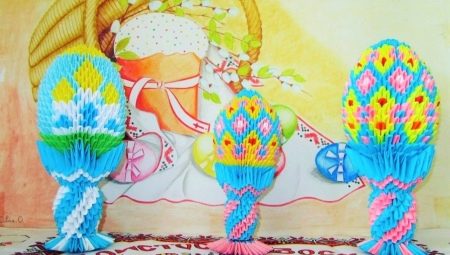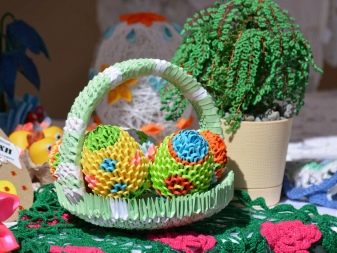Create Modular Origami Easter Eggs

Paper Easter eggs are best made using the modular origami technique, that is, from small squares of paper that have been pre-folded in a certain way. Egg figures are voluminous, attractive and very unusual. They can be used as a decoration for a festive table or presented as a gift.






How do I stack modules correctly?
Before you start making the eggs themselves, you need to learn how to make modules. To create these details, you need to take a sheet of A4 paper.

An important point: you can practice creating modules on a white sheet, which is usually used for printer printing. When the modules start to turn out neat and even, you can work with colored paper.
Paper modules are made from 1/32 or 1/16 rectangles. The manufacturing process of modules consists of several stages.
- The rectangle is folded in half, and then in half again.
- Next, you need to wrap the right and left sides so that you get a triangle. Then turn it upside down.
- The paper that will look out of the triangle must be loaded. Wrap the corners on the other side, and bend the part in half.
It should be remembered that the modules must be stiff enough to the touch. A more detailed diagram of the folding of parts is shown in the figure.


Classic version
As a presentation or just for decorating a festive table, you can make an Easter egg from modules with the inscription "ХВ". To work, you will need modules of different colors and in a certain amount (taking into account the future stand):
- yellow (designated as the base shade of the product) - 538 pieces;
- purple - 111 pieces;
- blue - 143 pieces;
- white - 50 pieces.

An important point: it is recommended to make modules with a margin, because in the process of work there is always a risk of spoiling several modular triangles. Modules may seem tedious at first, but they can actually be crafted pretty quickly. The most important thing is to understand the folding principle.
A master class on making an Easter egg in stages consists of several steps.
- At the very beginning, you need to take yellow modules for work. The first three rows are made of them, each of which will have 8 modules. The fourth row is folded so that one wing from the previous row fits into the modules from the next row. The result should be 16 wings.
- The fifth line consists of 8 yellow and 8 purple modules. They need to alternate with each other.
- The sixth consists of 16 purple modules. In the seventh row, the color is the same, but you need to thread the wing of the previous row into the pockets of the new purple modules. As a result, you should get 32 wings.
- The eighth row is assembled starting with the protruding module. The color scheme is 1 yellow and 3 purple.
- The ninth row consists of 32 modules of the main shade.
- The tenth row is quite complex in terms of color: 3 yellow, 2 blue, 1 yellow, 2 blue, and the rest are all yellow.
- 11: 2 blue, yellow, blue, yellow, 3 blue. The rest of the modules are yellow.
- 12: 2 s., F., 2 s., 2 f., 2 s., F., 2 s. The rest are yellow again.
- 13: 4 s., 3 w., 2 s., 2 w., Blue.
- 14 row: 3 s., 3 w., 2 s., Yellow, blue.
- 15 row: 2 s., 4 g., 3 s.
- 16 row: 3 s., 3 w., 2 s., 1 w., 2 s.
- 17 row: 4 s., 3 w., Blue, 3 w., Blue.
- 18 row: 2 s., Yellow, 2 s., 2 f., 2 s., 2 f., Blue.
- 19 row: 2 s., 2 f., 2 s., 2 f., Blue, 2 f., Blue.
- 20 row: 2 s., 3 w., 2 s., Yellow, 4 s.
- Row 21: yellow.
- 22 row: alternate purple and yellow.
- 23: base color.
- In the 24th row, the figure should begin to narrow slightly. Of the 32 modules you need to make 23. In some places, the module is put on three wings at once.
- The 25th row should already consist of 23 yellow triangles.

Origami in the form of an Easter egg is ready. But there is one small addition - gently flatten the egg with your hands to get a more regular shape.

Assembling eggs on a stand
For Easter, you can make an egg on a stand. The egg itself is collected according to the same principle as in the previous description. You can, if you wish, remove the inscription "XB", then the modules will be required in the same quantity, but already in plain colors.


Step-by-step instructions for creating a stand consists of the following steps.
- We make the top two rows. Each of them must contain 10 blue triangles.
- In the third row, blue and base colors alternate in the same amount.
- Row 4 contains 10 white triangles. In this case, they should be outward with the short side.
- The fifth row consists of 10 pieces of the main shade.
- The next one will have 20 white triangles (there is one pocket for one wing).
- The seventh row contains 20 blue modules.
- In the eighth, blue and yellow alternate.


Now we need to switch to creating one more delivery-related part. The first and second row will have 10 blue modules. Further, in the same amount, blue and yellow alternate. Further along the row: 20 white, 20 yellow and 10 purple details.


The finished result of all the work is shown in the figure. Please note that the color of the triangles may vary from case to case. The choice is highly individual. But regarding the material of manufacture, there are some requirements that must be observed.

So, it is not recommended to make modules from high density cardboard, as they can unfold during operation. And in general, it will not be very convenient to fold them. Good quality colored paper works best. It folds well, does not tear or wrinkle in the process.
There is one more important feature. It lies in the fact that the number of modules must be constantly counted and monitored. Otherwise, the craft may be damaged, it will have to be redone.

An egg made from paper modules, with careful treatment, can be preserved for more than one year. The main thing is that moisture, direct sunlight, there is no mechanical effect on it.




For more on creating modular origami in the form of Easter eggs, see the video below.








